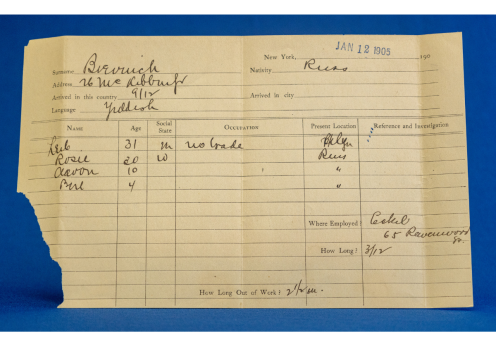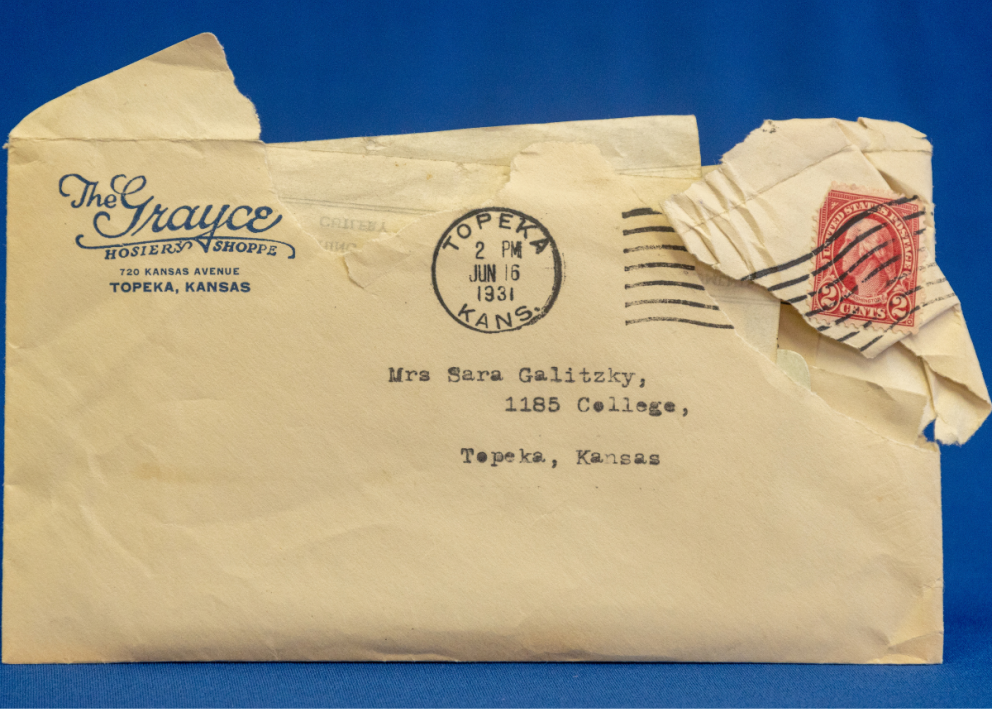
Building the Jewish Community in Kansas
This exhibit explores the community building efforts of Jewish Kansans from the early 1900s to the present day. By identifying employment opportunities and developing Kosher foodways, Jewish Kansans have fostered relationships of mutual aid for their local communities. Various social organizations have formed out of efforts to create safe places for Jewish cultural expression in rural Kansas.
Moving to the Midwest
Jewish immigration to Kansas began as early as the 1850s when the first Jewish cemeteries appeared on the Kansas landscape, followed by congregations and social organizations. Some Jewish immigrants came to Kansas after being pushed away from other locations due to antisemitism, lack of community support, and lack of access to resources. Other Jewish people came to Kansas to follow education and employment opportunities.

Yiddish Map of the U.S.
First-generation refugees are often forced to navigate foreign spaces in unfamiliar languages. Nearly all of the two-million Jewish people who immigrated from Eastern Europe between 1880 and 1924 spoke Yiddish. This map from the Industrial Removal Office provides essential information about U.S. states and cities for new Americans making their way across the country.
Industrial Removal Office, circa 1920s
IRO Agreement Form
In 1901, the the Industrial Removal Office (IRO) was created with the purpose of placing Jewish immigrants in Midwestern towns. Many American-born Jews believed that the density of the Eastern European Jewish population in East Coast cities was causing a rise in antisemitism. One response was to disperse Jews to the heartland.
Industrial Removal Office, circa 1900


Telegram from NY
The IRO arranged for (and sometimes pressured) local Jewish merchants and institutions to sponsor new immigrants. In Topeka, the Hebrew Ladies Benevolent Society worked with the IRO to find jobs and help settle new immigrants.
Western Union Telegraph Company, 1905
Unseen Labor
From the members of the Hebrew Ladies Benevolent Society and the local chapter of the National Council for Jewish Woman, to the current participants in the Lawrence Jewish Community Congregation, local Jewish women have played an integral role in creating supportive and welcoming Jewish communities. The often unseen labor of these women has been essential to creating Jewish community in the isolated setting of the Midwest.
Letter to the Hebrew Ladies Benevolent Society
Founded in 1885 by a group of German-speaking women, the Hebrew Ladies Benevolent Society (HBLS) admitted new Eastern European women moving to Topeka after the turn of the century. Through the 19th and into the 20th century, the society provided community charitable services. Participation faded at the end of the 1930s.
Unknown author, circa 1898


Tzedakah
The HLBS played a major role in tzedakah (the Hebrew word for justice and charity), performing social services and charitable giving. During the depression they assisted unhoused Jews passing through Topeka. They would provide meals, a place to sleep for a night, and a bus or train ticket to a major city—Kansas City or Denver—which had greater resources to provide assistance.
Hebrew Ladies Benevolent Society (HLBS), circa 1900

Donation to Jewish Consumptives' Relief Society
In addition to supporting the local charities through their dues and fundraising, the HLBS also donated to national organizations, including the Cleveland Jewish Orphan Asylum, Denver hospitals, and the Hebrew Union College in Cincinnati.
The Jewish Consumptives' Relief Society, 1906
Community Organizations
Through the years, there have been several local Jewish social organizations and Jewish owned businesses in Lawrence and the surrounding areas. While not all of these services exist today, their records and materials indicate the continuous individual and communal attempts to build and maintain community in the Midwest.
Lawrence Jewish Community Congregation Newsletter
An increase in Jewish university students and faculty, especially those with growing families, spurred the organization of the Lawrence Jewish Community Congregation (LJCC) in the 1940s. The group acquired a house near campus to host Hebrew and Sunday school classes, social activities, occasional services, and the newly formed Hillel chapter. The LJCC’s ongoing mission is to serve as an umbrella community for all Jews in Lawrence.
Lawrence Jewish Community Congregation, 1975


KU Hillel Kippah
Hillel was founded in 1923 to serve Jewish students on U.S. campuses who were entering universities in large numbers. At the time, many universities were beginning to adopt quotas to limit Jewish students on campus. KU Hillel started in the 1940s, as the G.I. Bill spurred college enrollment. For a long time Hillel was the only campus organization serving Jewish students; on most campuses today, there is a Hillel and Chabad presence. From time to time, Hillel issues its own yarmulke.
KU Hillel, date unknown

Chabad KU Kippah
Rabbi Zalman Teichtel, his wife Nechama, and daughter Mina moved to Lawrence in 2006 to represent the Lubavitcher movement, and opened a Chabad House to serve students and the regional community. Dedicated to outreach, they host services, promote Jewish learning, and promote Jewish tradition. The Chabad yarmulke or head covering, with its Jayhawk, combines modernism with tradition.
Chabad Center for Jewish Life, 2010
Blintz Brunch Poster
The Blintz Brunch was established to celebrate many aspects of Jewish life and heritage, but especially food. The Brunch always includes blintzes and bagels with lox spread. The Brunch is also a bake sale, with challah, rye breads, kosher salamis, babkas, and baked goods made by congregation members. In addition, it brings together nearly all Jewish people in town, not just congregants, who help to prepare and run the Blintz Brunch.
Herta Galton, date unknown

Lawrence Sanitary Milk Co. Bottle
The Lawrence Sanitary Milk Co. was a Jewish-owned dairy from 1920 until 1959, when it was purchased by the Milk Producers Marketing Co. (All Star Dairy). The founders, brothers Simon and Samuel Hurwitz left Russia in 1912, joining their elder brother Max on his small dairy farm in Topeka. After serving in WWI, Simon and Samuel moved to Lawrence, opening the Lawrence Sanitary Milk and Ice Cream Co. In the 1930s Sam left the firm, entering the wholesale grocery and produce business as Food Supply, Inc.
Lawrence Sanitary Milk Co., circa 1950s

Joys of Jewish Cooking Cookbook
In 1969, local Jewish women prepared a cookbook and printed it at the World Company Printers in Lawrence. In their preface, they described the joy felt in sharing these recipes, as well as the difficulties associated with writing down specific directions. Often, their recipes were based on oral lessons, where a mother or grandmother would teach her daughters through verbal direction and practice. Many of the measurements were originally based on gut feeling, rather than exact measurements.
Jewish Community Women, 1969

This digital project is based on the 2024 pop-up exhibition titled Homemaking. This exhibit was an original a feature of the 2024 Jews in the Americas Conference, and was curated by KU Museum Studies graduate student, Dominique Stringer. Photographs and artifacts were provide by faculty emeritus, Dr. David and Mrs. Sharyn Brooks Katzman, the Lawrence Jewish Community Congregation, and the Midwest Center for Holocaust Education. The exhibit was overseen and organized by Tyra Kalman and Dr. Rami Zeedan of KU Jewish Studies. The Center for Global and International Studies co-hosted this exhibit. KU Hillel housed the exhibit which was open for public viewing April 15th through April 19th, 2024.























